Influence of Graphite/Graphene on the Tribological Behaviors of Self-Lubricating Fabric Composite
Abstract
:1. Introduction
2. Experimental
2.1. Materials
2.2. Specimen Preparation
2.3. Tensile Strength Test
2.4. Friction and Wear Test
2.5. Oscillating Wear Test
2.6. Characterization
3. Result and Discussion
3.1. The Effect of Graphite/Graphene on the Tribological Property of Hybrid PTFE/Nomex Fabric Composite
3.2. The Effect of Graphene Content on the Tribological Property of the Graphite/Graphene-Filled PTFE/Nomex Fabric Composite
3.3. The Effect of Graphite Content on the Tribological Property of the Graphite/Graphene-Filled PTFE/Nomex Fabric Composite
3.4. Oscillating Wear Test for Bearing Application
3.4.1. Experimental
3.4.2. Wear Test Results
3.4.3. Worn Surface Analysis
4. Conclusions
Author Contributions
Funding
Conflicts of Interest
References
- Liu, Y.; Xu, N.; Wang, Y.; Yao, Y.; Xiao, H.; Jia, J.; Lv, H.; Zhang, D. Preparation and tribological properties of hybrid PTFE/Kevlar fabric self-lubricating composites. Surf. Coat. Technol. 2019, 361, 196–205. [Google Scholar] [CrossRef]
- Qiu, M.; Yang, Z.; Lu, J.; Li, Y.; Zhou, D. Influence of step load on tribological properties of self-lubricating radial spherical plain bearings with PTFE fabric liner. Tribol. Int. 2017, 113, 344–353. [Google Scholar] [CrossRef]
- Sun, L.-H.; Yang, Z.-G.; Li, X.-H. Tensile and tribological properties of PTFE and nanoparticles modified epoxy-based polyester fabric composites. Mater. Sci. Eng. A 2008, 497, 487–494. [Google Scholar] [CrossRef]
- Lu, Q.-S.; Sun, L.-H.; Yang, Z.-G.; Li, X.-H.; Jin, S.-L. Optimization on the thermal and tensile influencing factors of polyurethane-based polyester fabric composites. Compos. Part A Appl. Sci. Manuf. 2010, 41, 997–1005. [Google Scholar] [CrossRef]
- Russo, P.; Acierno, D.; Simeoli, G.; Iannace, S.; Sorrentino, L. Flexural and impact response of woven glass fiber fabric/polypropylene composites. Compos. Part B Eng. 2013, 54, 415–421. [Google Scholar] [CrossRef]
- Qiu, M.; Gao, Z.L.; Yao, S.J.; Chen, L. Effects of Oscillation Frequency on the Tribological Properties of Self-Lubrication Spherical Plain Bearings with PTFE Woven Liner. Key Eng. Mater. 2011, 455, 406–410. [Google Scholar] [CrossRef]
- Ren, G.; Zhang, Z.; Zhu, X.; Yang, M.; Men, X.; Jiang, W.; Liu, W. WS2-filled hybrid PTFE/Nomex fabric composites with improved antiwear property. J. Mater. Sci. 2015, 50, 1065–1070. [Google Scholar] [CrossRef]
- Ren, G.; Zhang, Z.; Zhu, X.; Yang, M.; Men, X.; Jiang, W.; Liu, W. High-temperature tribological performance of hybrid PTFE/Nomex fabric/phenolic composite. Compos. Sci. Technol. 2014, 104, 146–151. [Google Scholar] [CrossRef]
- Friedrich, K.; Zhang, Z.; Schlarb, A.K. Effects of various fillers on the sliding wear of polymer composites. Compos. Sci. Technol. 2005, 65, 2329–2343. [Google Scholar] [CrossRef]
- Sun, W.; Gu, Y.; Yang, Z.; Li, M.; Wang, S.; Zhang, Z. Enhanced tribological performance of hybrid polytetrafluoroethylene/Kevlar fabric composite filled with milled pitch-based carbon fibers. J. Appl. Polym. Sci. 2018, 135, 46269. [Google Scholar] [CrossRef]
- Conte, M.; Igartua, A. Study of PTFE composites tribological behavior. Wear 2012, 296, 568–574. [Google Scholar] [CrossRef]
- Qiu, M.; Miao, Y.; Li, Y.; Lu, J. Film-forming mechanisms for self-lubricating radial spherical plain bearings with hybrid PTFE/aramid fabric liners modified by ultrasonic. Tribol. Int. 2015, 87, 132–138. [Google Scholar] [CrossRef]
- Li, H.L.; Yin, Z.W.; Jiang, D.; Jin, L.Y.; Cao, Q.; Qu, Y.F. A Study of the Static/Kinetic Friction Behavior of PTFE-Based Fabric Composites. Tribol. Trans. 2018, 61, 122–132. [Google Scholar] [CrossRef]
- Yang, M.; Zhu, X.; Ren, G.; Men, X.; Guo, F.; Li, P.; Zhang, Z. Influence of air-plasma treatment and hexagonal boron nitride as filler on the high temperature tribological behaviors of hybrid PTFE/Nomex fabric/phenolic composite. Eur. Polym. J. 2015, 67, 143–151. [Google Scholar] [CrossRef]
- Luo, D.; Fei, J.; Zhang, C.; Li, H.; Zhang, L.; Huang, J. Optimization of mechanical and tribological properties of carbon fabric/resin composites via controlling ZnO nanorods morphology. Ceram. Int. 2018, 44, 15393–15401. [Google Scholar] [CrossRef]
- Kumar, V.; Sinha, S.K.; Agarwal, A.K. Tribological studies of epoxy composites with solid and liquid fillers. Tribol. Int. 2017, 105, 27–36. [Google Scholar] [CrossRef]
- Gu, D.; Yang, Y.; Qi, X.; Deng, W.; Shi, L. Influence of weave structures on the tribological properties of hybrid Kevlar/PTFE fabric composites. Chin. J. Mech. Eng. 2012, 25, 1044–1051. [Google Scholar] [CrossRef]
- Ren, G.; Zhang, Z.; Zhu, X.; Men, X.; Jiang, W.; Liu, W. Combined effect of air-plasma treatment and lubricant filling on the dry sliding wear behavior of hybrid PTFE/Nomex fabric/phenolic composite. Compos. Sci. Technol. 2014, 100, 204–211. [Google Scholar] [CrossRef]
- Yuan, J.; Zhang, Z.; Yang, M.; Guo, F.; Men, X.; Liu, W. Surface modification of hybrid-fabric composites with amino silane and polydopamine for enhanced mechanical and tribological behaviors. Tribol. Int. 2017, 107, 10–17. [Google Scholar] [CrossRef]
- Liu, P.; Lu, R.; Huang, T.; Wang, H.; Li, T. A Study on the Mechanical and Tribological Properties of Carbon Fabric/PTFE Composites. J. Macromol. Sci. Part B 2012, 51, 786–797. [Google Scholar] [CrossRef]
- Sun, Y.; Zhang, Q.; Gao, L.; Zhou, X.; Cheng, Y.; Zhang, P. Experimental study on tribological properties of carbon/polytetrafluoroethylene hybrid fabric reinforced composite under heavy loads and oil lubrication. Tribol. Int. 2016, 94, 82–86. [Google Scholar] [CrossRef]
- Xue, Y.; Chen, J.; Guo, S.; Meng, Q.; Luo, J. Finite element simulation and experimental test of the wear behavior for self-lubricating spherical plain bearings. Friction 2018, 6, 297–306. [Google Scholar] [CrossRef] [Green Version]
- Cai, P.; Wang, T.; Wang, Q. Effect of several solid lubricants on the mechanical and tribological properties of phenolic resin-based composites. Polym. Compos. 2015, 36, 2203–2211. [Google Scholar] [CrossRef]
- Li, H.; Yin, Z.; Jiang, D.; Huo, Y.; Cui, Y. Tribological behavior of hybrid PTFE/Kevlar fabric composites with nano-Si3N4 and submicron size WS2 fillers. Tribol. Int. 2014, 80, 172–178. [Google Scholar] [CrossRef]
- Yuan, J.; Zhang, Z.; Yang, M.; Li, P.; Men, X.; Liu, W. Graphene Oxide-Grafted Hybrid-Fabric Composites with Simultaneously Improved Mechanical and Tribological Properties. Tribol. Lett. 2018, 66, 28. [Google Scholar] [CrossRef]
- Wang, Q.; Zhang, X.; Pei, X.; Wang, T. Friction and wear properties of solid lubricants filled/carbon fabric reinforced phenolic composites. J. Appl. Polym. Sci. 2010, 117, 2480–2485. [Google Scholar] [CrossRef]
- Ren, G.; Zhang, Z.; Zhu, X.; Ge, B.; Guo, F.; Men, X.; Liu, W. Influence of functional graphene as filler on the tribological behaviors of Nomex fabric/phenolic composite. Compos. Part A Appl. Sci. Manuf. 2013, 49, 157–164. [Google Scholar] [CrossRef]
- Su, F.H.; Zhang, Z.Z.; Guo, F.; Wang, K.; Liu, W.-M. Effects of solid lubricants on friction and wear properties of Nomex fabric composites. Mater. Sci. Eng. A 2006, 424, 333–339. [Google Scholar] [CrossRef]
- Lin, L.Y.; Kim, D.E.; Kim, W.K.; Jun, S.C. Friction and wear characteristics of multi-layer graphene films investigated by atomic force microscopy. Surf. Coat. Technol. 2011, 205, 4864–4869. [Google Scholar] [CrossRef]
- Zhang, X.; Pei, X.-Q.; Wang, Q.; Wang, Y.; Chen, S. The friction and wear properties of carbon nanotubes/graphite/carbon fabric reinforced phenolic polymer composites. Adv. Compos. Mater. 2014, 24, 1–13. [Google Scholar] [CrossRef]
- Ren, G.; Zhang, Z.; Zhu, X.; Men, X.; Liu, W. Influence of lubricant filling on the dry sliding wear behaviors of hybrid PTFE/Nomex fabric composite. J. Mater. Sci. 2014, 49, 3716–3724. [Google Scholar] [CrossRef]
- Zhang, H.J.; Zhang, Z.Z.; Guo, F. Studies of the Influence of Graphite and MoS2 on the Tribological Behaviors of Hybrid PTFE/Nomex Fabric Composite. Tribol. Trans. 2011, 54, 417–423. [Google Scholar] [CrossRef]
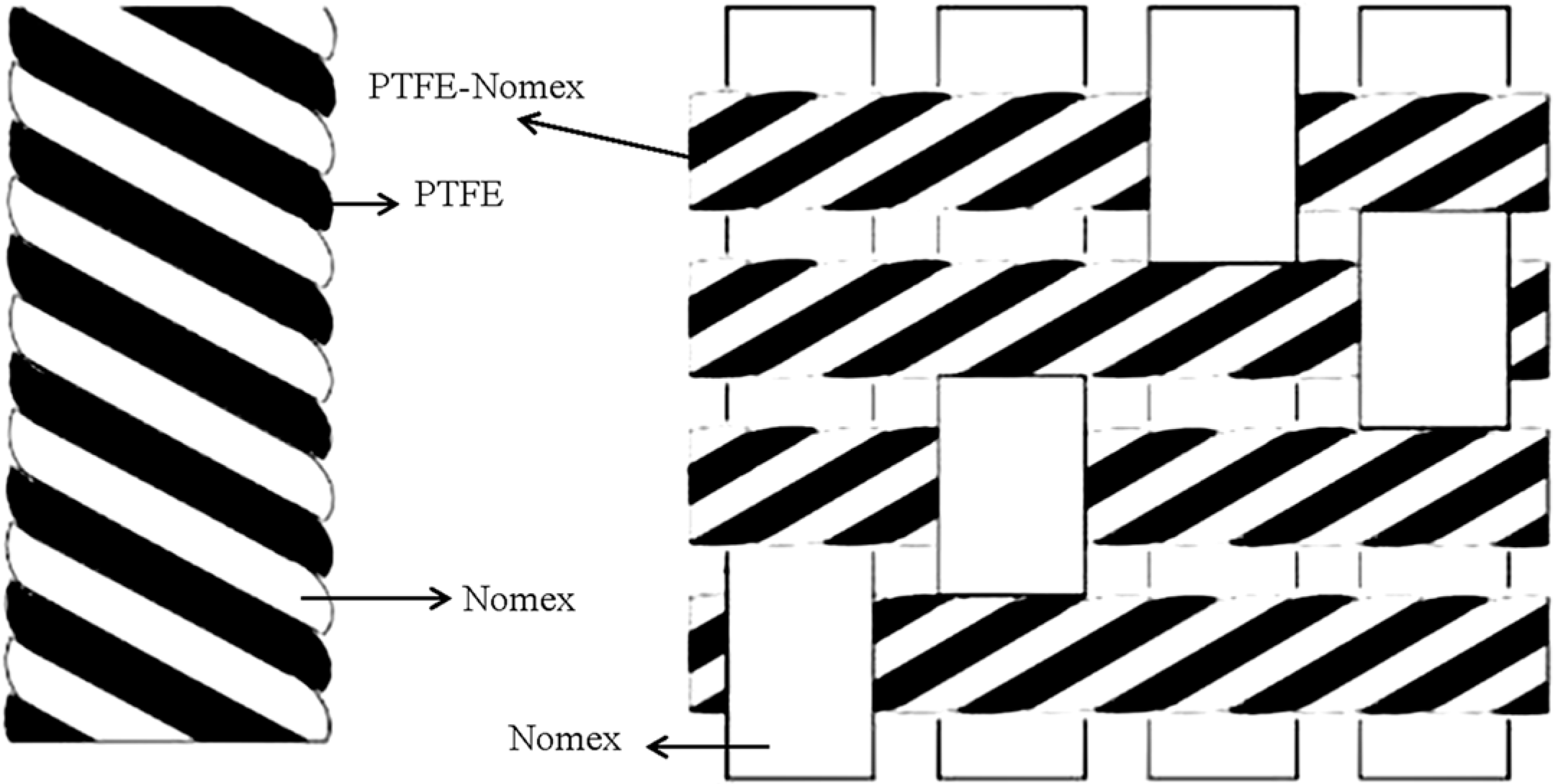
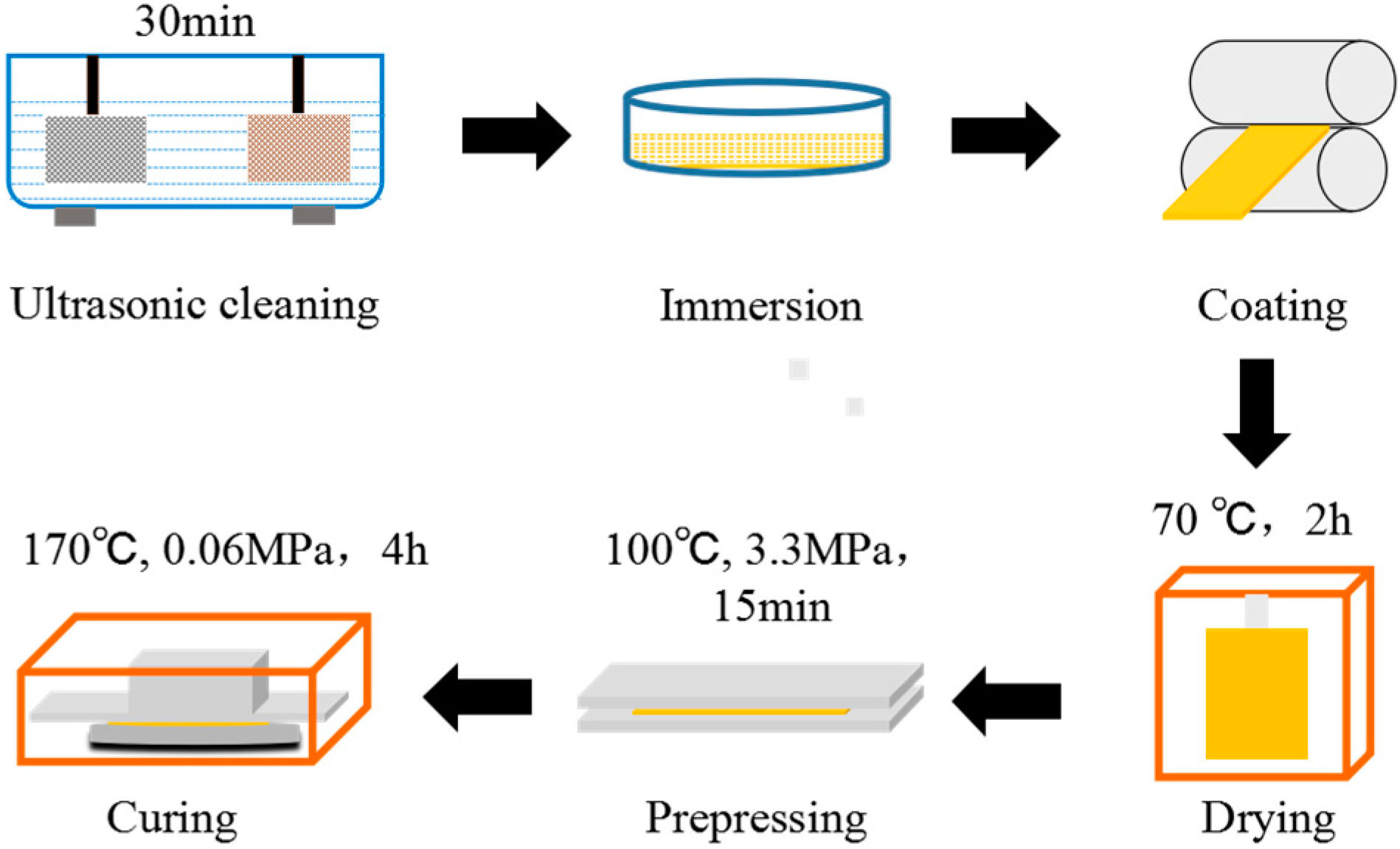
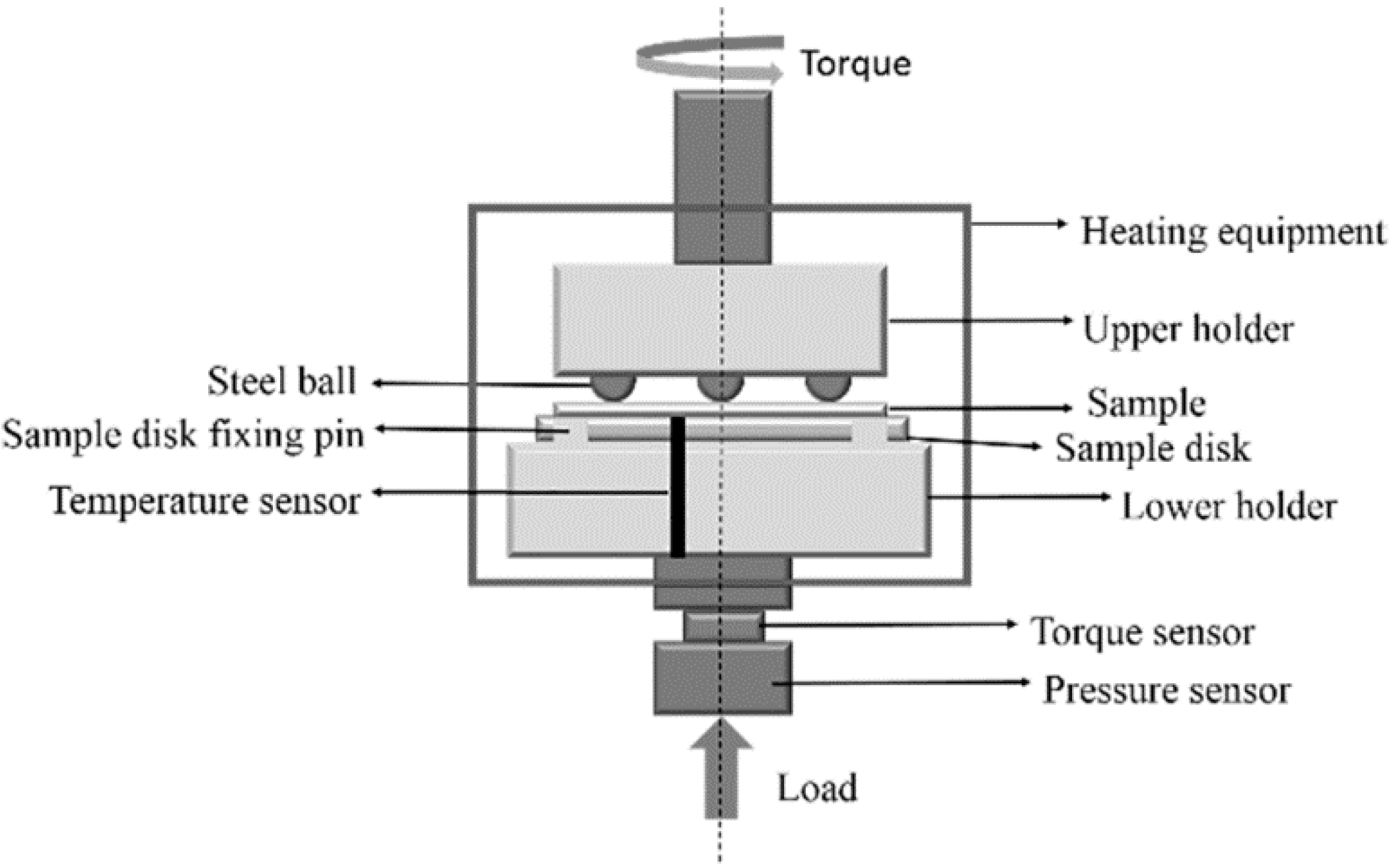

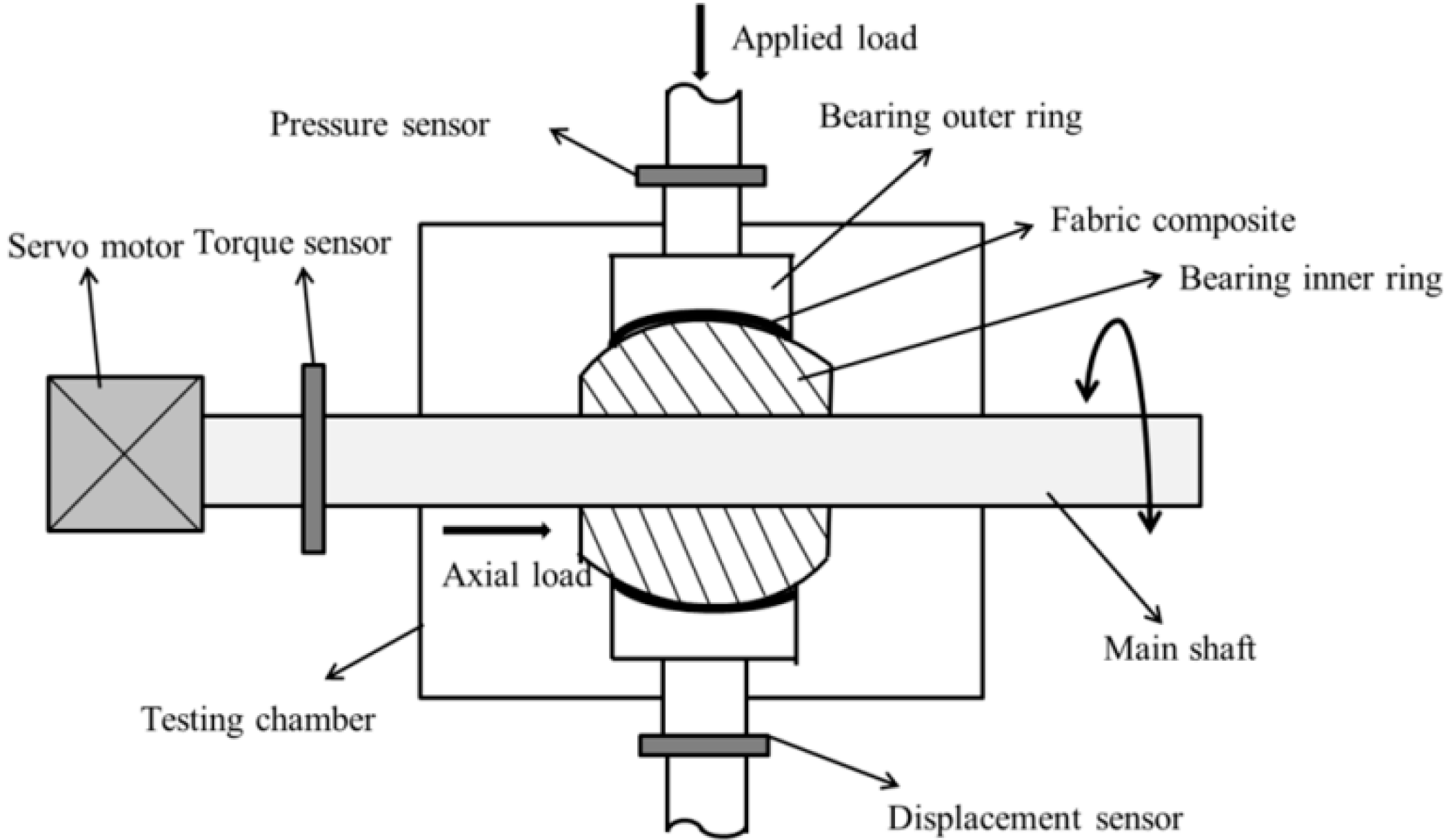
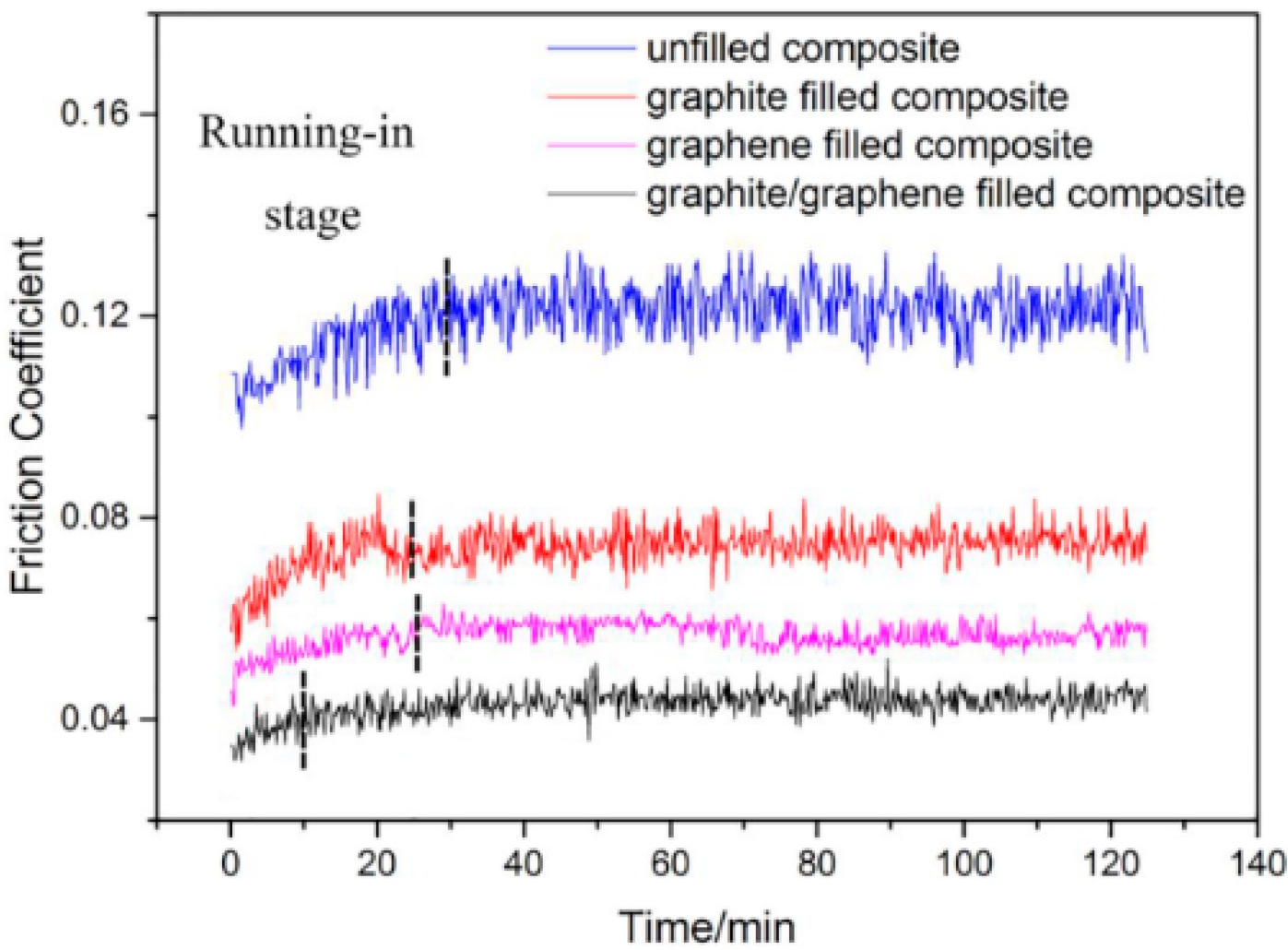
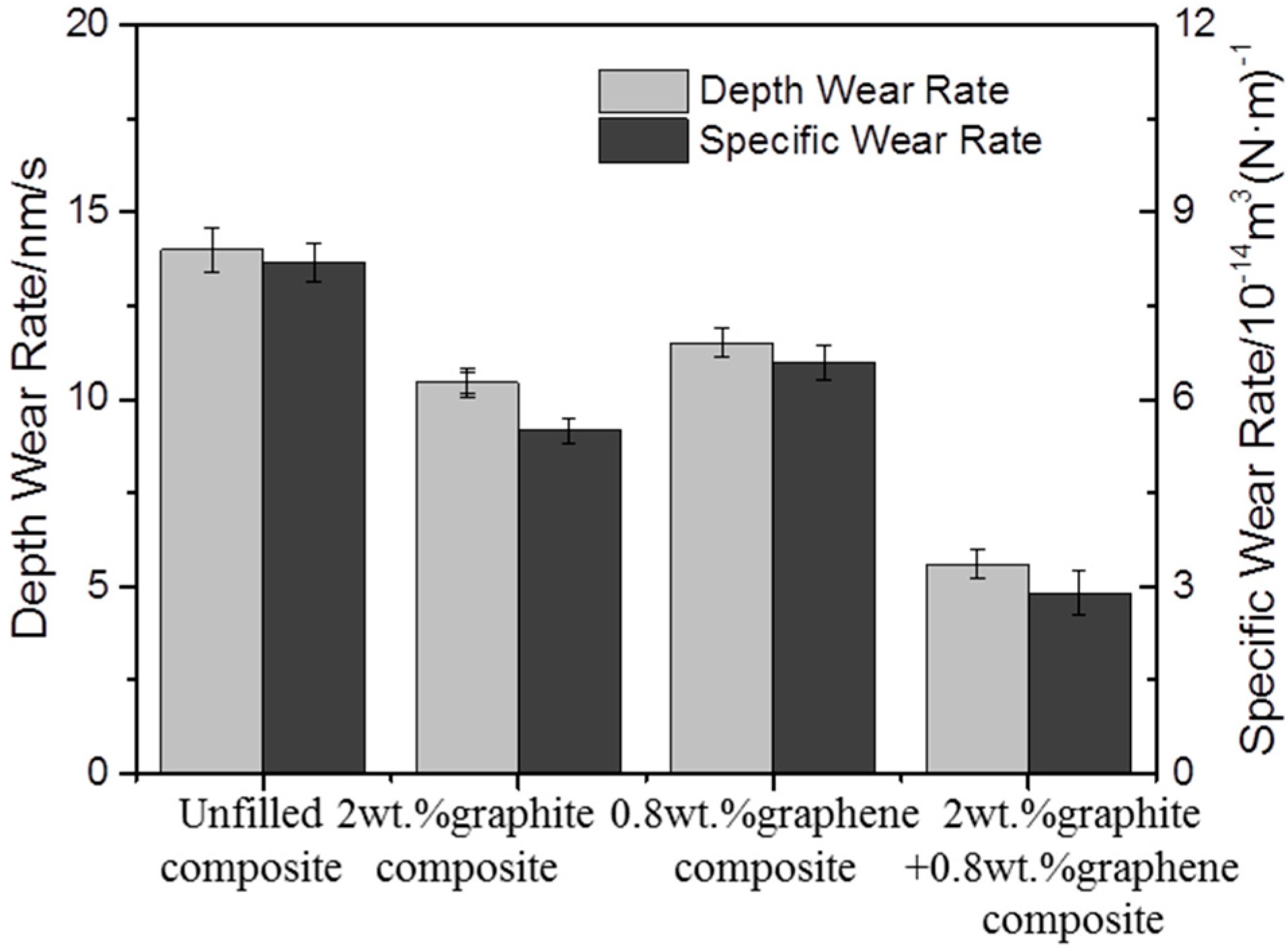




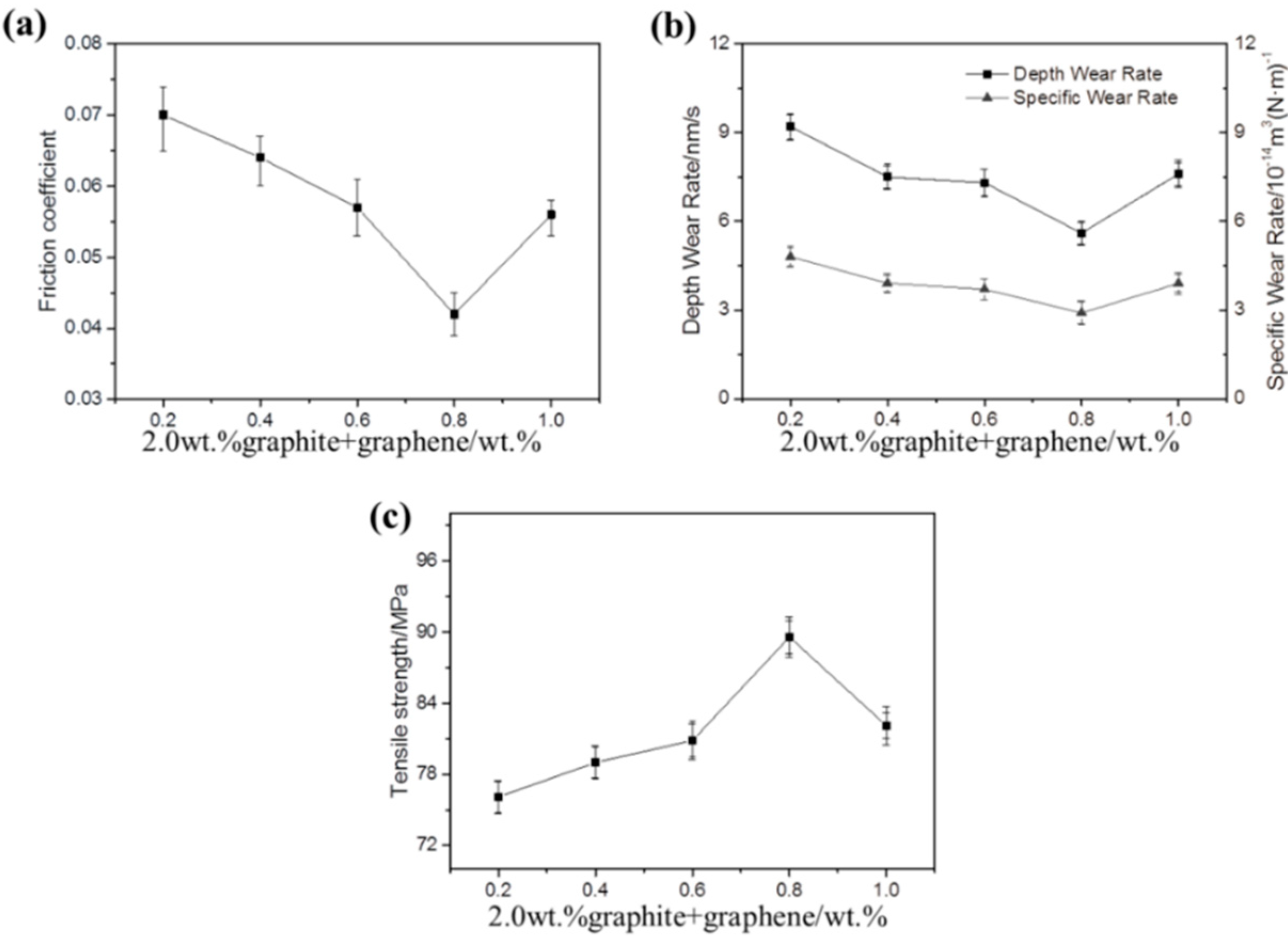


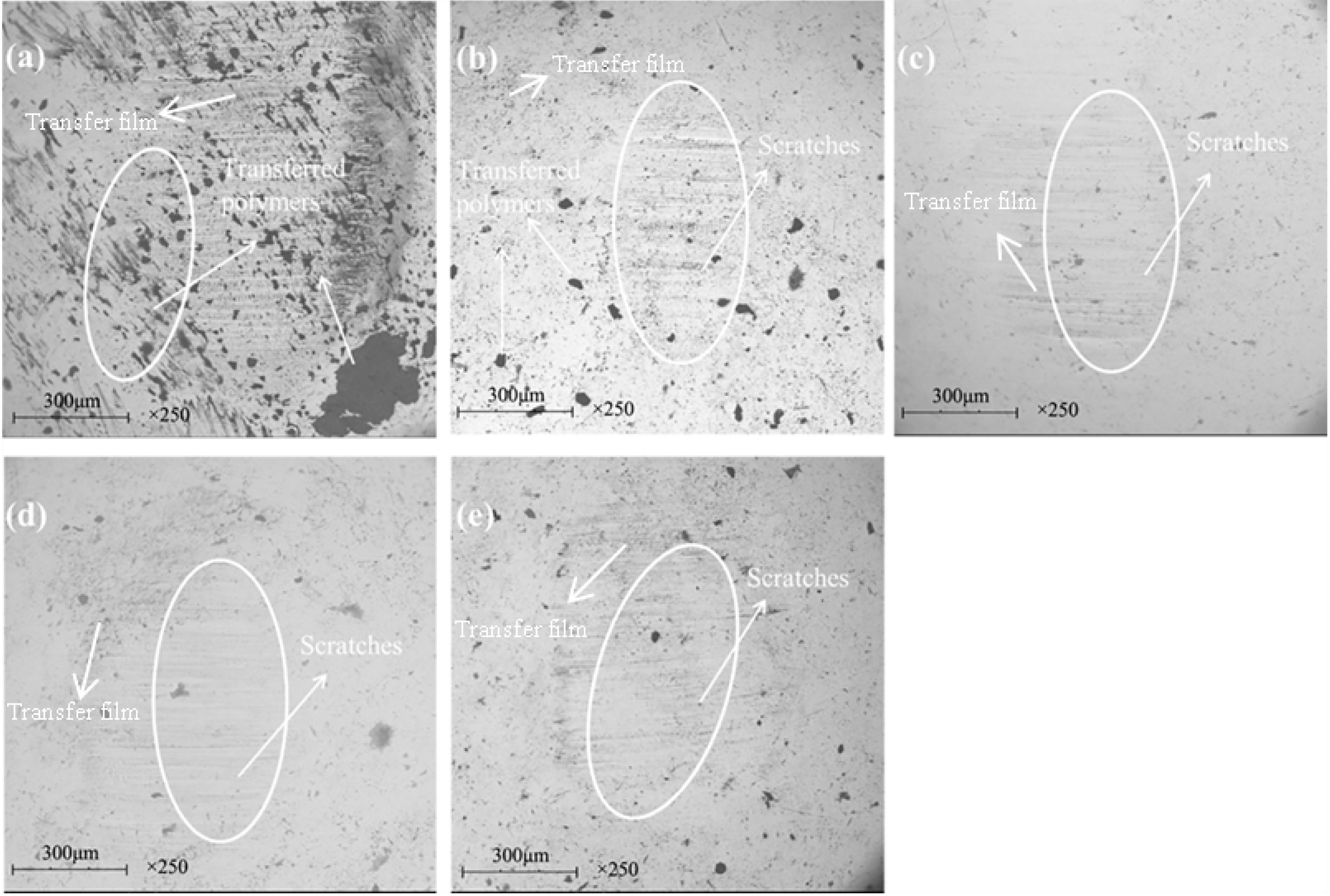

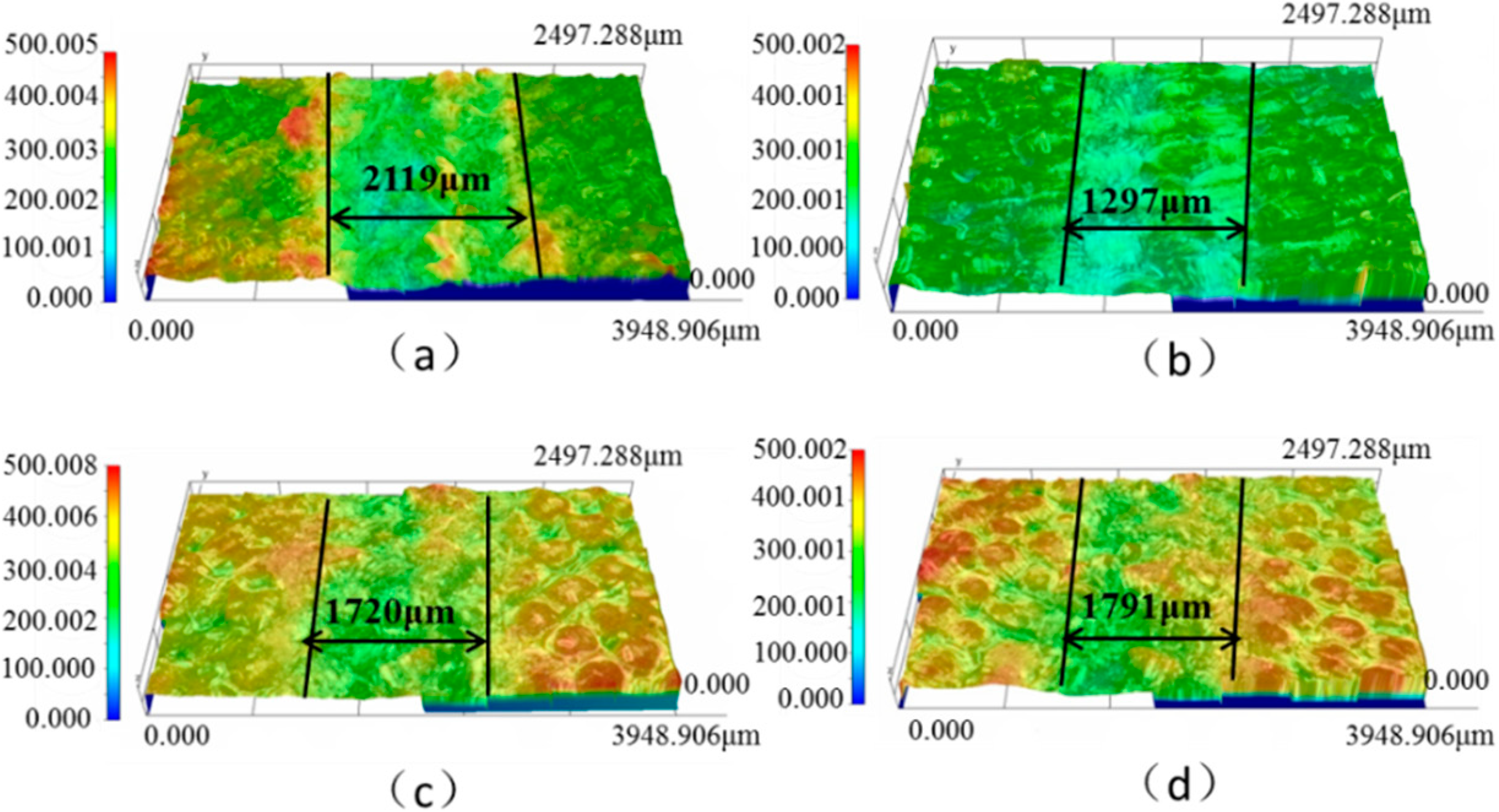

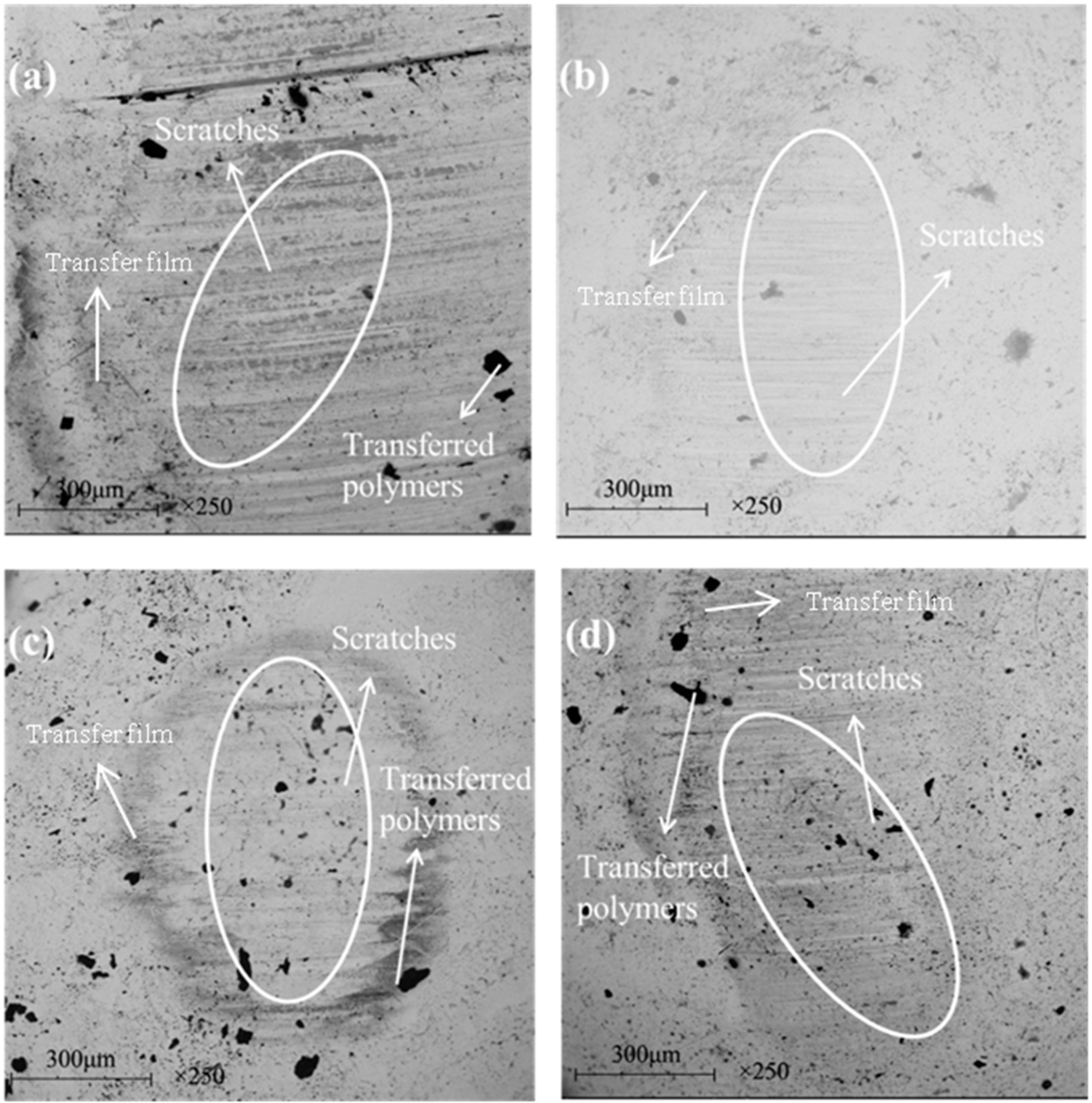

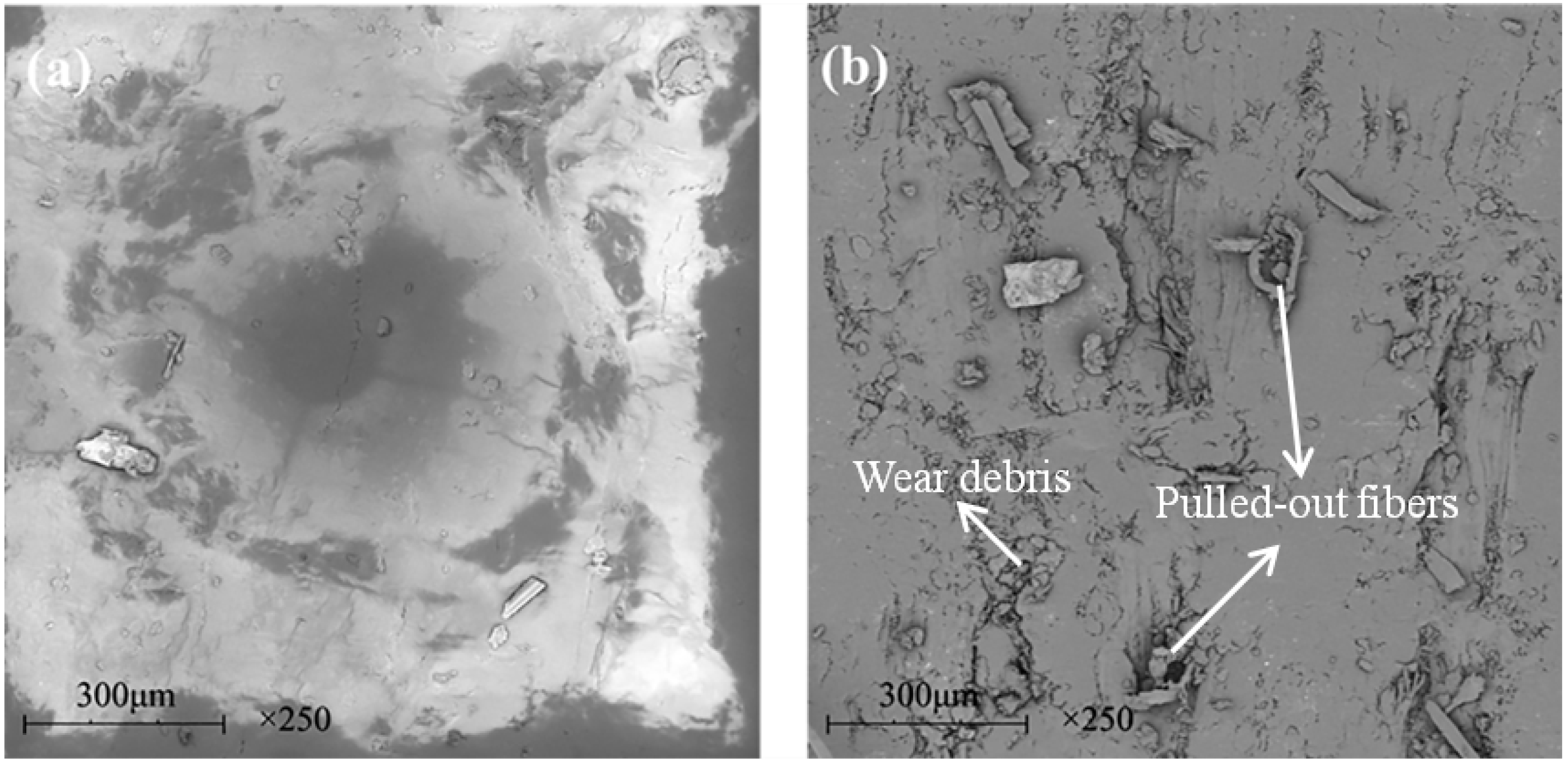
| Weave Density (Threads/Inch) | Filament Numbers of a Yarn | |||
|---|---|---|---|---|
| Fabric | Nomex-PTFE | Nomex | PTFE | Nomex |
| PTFE/Nomex | 35 | 55 | 60 | 100 |
| Final Sample | Phenolic Resin (wt %) | Graphite (wt %) | Grapheme (wt %) |
|---|---|---|---|
| 1# | 100 | ||
| 2# | 97.8 | 2 | 0.2 |
| 2# | 97.6 | 2 | 0.4 |
| 4# | 97.4 | 2 | 0.6 |
| 5# | 97.2 | 2 | 0.8 |
| 5# | 97 | 2 | 1.0 |
| 6# | 98.2 | 1 | 0.8 |
| 7# | 94.2 | 5 | 0.8 |
| 8# | 89.2 | 10 | 0.8 |
| Applied Load | Frequency | Oscillation Angle | Temperature | Oscillation Times |
|---|---|---|---|---|
| 44.4 kN | 0.2 Hz | ±25° | 25 °C | 100,000 |
© 2020 by the authors. Licensee MDPI, Basel, Switzerland. This article is an open access article distributed under the terms and conditions of the Creative Commons Attribution (CC BY) license (http://creativecommons.org/licenses/by/4.0/).
Share and Cite
Ren, F.; Wang, S.; Yu, M.; Duan, H.; Su, M.; Ren, M.; Sun, J. Influence of Graphite/Graphene on the Tribological Behaviors of Self-Lubricating Fabric Composite. Materials 2020, 13, 232. https://doi.org/10.3390/ma13010232
Ren F, Wang S, Yu M, Duan H, Su M, Ren M, Sun J. Influence of Graphite/Graphene on the Tribological Behaviors of Self-Lubricating Fabric Composite. Materials. 2020; 13(1):232. https://doi.org/10.3390/ma13010232
Chicago/Turabian StyleRen, Fang, Sha Wang, Mingming Yu, Hongyu Duan, Meng Su, Musu Ren, and Jinliang Sun. 2020. "Influence of Graphite/Graphene on the Tribological Behaviors of Self-Lubricating Fabric Composite" Materials 13, no. 1: 232. https://doi.org/10.3390/ma13010232




